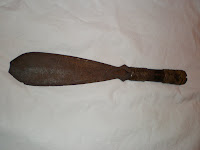
I paid very little for this old Northern Filipino ("Igorot") knife/spear blade a few months ago. The item was poorly described and the pictures were terrible, and I was not particularly surprised when I opened the package and discovered a blade in very poor shape. Still, it's an older piece and one made for use, so it was worthwhile. This is an example of a peculiar necktie-shaped spear blade, known as a hinalung, that doubles as a knife. Although any spear blade could conceivably double as a knife, these are designed to serve as both utilitarian knife and hunting weapon.
The hinalung is strongly influenced by the socketed Filipino spears known as budiaks or budjaks. Originally a permanently-mounted spear blade (and originally much slimmer in shape), the hinalung would have been an effective hunting/martial weapon. At some point, possibly during the American occupation during the early 20th century, the Igorots turned the hinalung into a dual use weapon to circumvent weapons laws. (See the essay "Hinalung & Pinahig: Weapon-Tools of the Igorot" on the excellent website Mediaeval Sword Resource Site for more & better information.) The blades were kept in open wood scabbards, similar to those used throughout Indonesia and on into Taiwan. The weapon suffers from the compromises needed to create a dual-use weapon - it's stubby, unwieldy, and not particularly comfortable to hold.
Overall, the point is short and wide (i. e., stubby). The item is forged from one piece of steel, probably recycled from an old automobile leaf spring or similar. The blade is ovoid in cross-section with evidence of repeated sharpening. The socket/handle is bound with several bands of woven rattan, each about 1/3" wide.
The item is in very poor shape. Superficially, the blade appears well-used, with an even dark, dusty patina, light rust, and pitting. At least 1/2" is broken off the tip, and the left-hand edge (when viewed from the side with the seam) is chipped in several places. The rattan rings are grimy from use.
I suspect this is a WWII era piece. I believe most Filipino artifacts date from 3 eras: the Spanish-American War/Philippine Insurrection period (1890-1910 or so, see "Uncle Sam, The Moros, and the Moro Campaigns" for more info), during or shortly after WWII (1940-1950), and the Vietnam era (1965-1975 or so), when GIs were stationed in the Philippines. I doubt this hinalung is particularly old, but it's well made overall and was not made for sale to tourists.
Length (overall): About 11 1/2". Would have been about 12" if complete.
Length (blades/points): About 6" from tip of blade to base of hilt.
Length (other dimensions): Handle/socket is about 5".
Width at widest point (blade/point): About 2" across at the widest point.
Width (other dimensions): Handle/socket is about 1" in diameter.
Materials: Recycled steel.
A nice addition to my small Filipino collection, which also includes several talibong-type knives, a bow, and a few arrows. I also have a contemporary tourist-art Filipino crossbow I am attempting to sell.



No comments:
Post a Comment